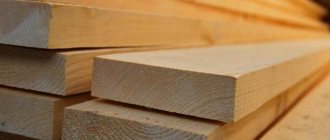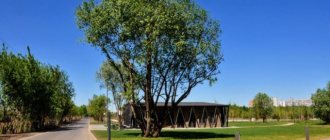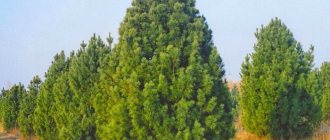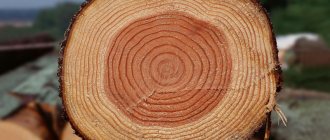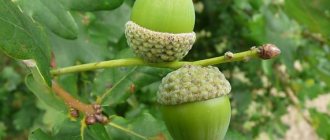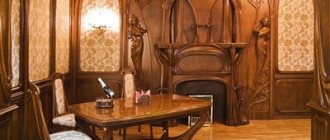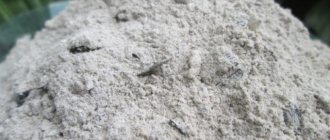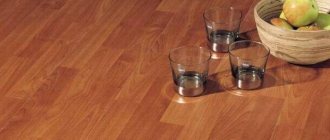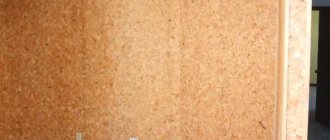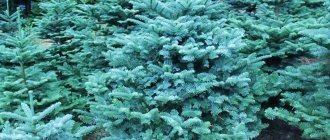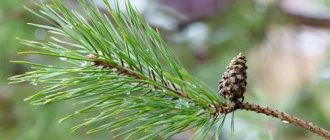Pine (from the Latin Pinus) is the name of evergreen trees, shrubs and dwarf trees of the Pine family, which are distinguished by needle-like needles, growing in bunches of 2-5 pieces and lignified cones. Pine has flaky bark and a developed root system that penetrates deep underground and spreads around the tree. Pine roots develop in accordance with the characteristics of the soil, which is why they are called “plastic”. Due to this property, pine is used for artificial afforestation of unfavorable arid, swampy or poor soils.
The average lifespan of a pine tree is 350 years; the maximum height of pine trees reaches 75 meters.
In total, about 130 species of pine are known, growing in temperate and subtropical climate zones.
Scots pine (Pinus silvestris) grows throughout Belarus and Russia and is widely harvested for woodworking purposes.
Description, reproduction and distribution area of Scots pine
Coniferous evergreen tree of the pine family (Pinaceae), up to 50 m high.
The trunk is straight, with whorled branching, covered with red-brown, cracking bark.
The buds are oval, covered with dry fringed scales, glued together with protruding resin.
The leaves (needles) are long, hard, needle-shaped, dark green, arranged in pairs on short shoots, and last for 2-3 years.
Staminate spikelets are numerous, gray-yellow, crowded at the base of the shoot; pistillate spikelets (cones) are located on the same tree at the tops of the shoots, grayish-brown. After fertilization, the cones grow, become woody, and the seeds ripen after 18 months. In March they fall out of the buds and soon germinate.
The seeds are elongated-ovate.
Blooms in May - June from 15 years.
Propagated by seeds. Lives up to 350-400 years.
Pine is widespread throughout almost the entire forest zone of the CIS. The growth in height in favorable soil and climatic conditions reaches 70-80 cm. It grows on sandy, sandy loam, podzolic, turf, gley and peat-bog soils.
An ancient Greek legend claims that the plant got its name from the nymph Pityos. Pitya was very fond of the cheerful and mischievous god Pan, the patron saint of fishermen and hunters. And Boreas, the god of the cold north wind, was just as jealous of her. Out of jealousy, he transformed the nymph into a beautiful evergreen tree, called Pinus. And Pan was often depicted with a pine wreath on his head.
Pine is one of the oldest medicinal plants. Its needles were included in compresses and poultices 5,000 years ago. In Ancient Egypt, pine resin was included in embalming compositions. It has been proven that these compounds still (after 3000 years) have not lost their bactericidal properties. In Greece and Rome, pine was used to treat colds. In Rus', it was customary to chew pine resin to strengthen teeth, gums, and to disinfect the oral cavity.
Characteristics
Ship pines are those that reach a height of about 40 m by the age of 80-100 years and have a straight trunk with a diameter of 0.5 m without knots. The main characteristics of such trees:
- the wood is light, resinous, durable, strong, elastic;
- tall pine;
- The trunk is erect, fairly uniform in height, without knots.
Pines cope well along the river and do not rot, thanks to their low weight and resin. In shipbuilding, the part of the tree was taken into account, and in which direction of the world this or that part was directed. There are no branches at the base of the trunk and the wood fibers are straight, so the log is suitable for keeling or sawing into long boards. On the north side, the tree receives less light and heat, so the structure is formed more dense and finely layered, used for the construction of the most important parts.
Mast pine must be at least 0.5 m in diameter; only slender, tall specimens are suitable for making durable ship masts. Less strong varieties were used for the construction of improvised means and scaffolding. Pine resin was used to impregnate the fabric of sails, ropes, and grooves.
Ship pines are those that reach a height of about 40 m by the age of 80-100 years.
Collection, preparation and drying of Scots pine
For medicinal purposes, pine buds, pollen, pine needles, resin (resin), and products obtained from pine are used: turpentine, tar, rosin, wood vinegar. The buds are collected in the spring in March - April, when they are swollen, but have not begun to grow and the scales covering them are pressed to the bud and glued together. If harvested too early (in February), the buds are small and contain fewer biologically active substances. The collection is carried out during spring felling of forests and sanitary cleaning of pine plantings. When collecting in young forest plantings, it is strictly forbidden to collect apical buds. The destruction of the apical bud makes the tree unsuitable for future production of commercial timber. The buds are collected in whole groups in the form of crowns (with the remains of branches about 3 mm long), cutting them off with a knife or tearing them off by hand. Single buds separated during harvesting are also used. Buds are not collected from old trees because they are too small. The collected pine buds are dried in attics or under sheds with good ventilation, spread out in a thin layer (3-4 cm). You cannot dry raw materials in attics with an iron roof or in dryers, since with this drying method the bud resin melts, often reducing the quality of the raw materials. In good weather, in attics and under sheds, the raw materials dry out in 5-10 days. The shelf life of raw materials is 2 years. The smell of the raw material is aromatic, resinous, the taste is bitter, the color is pinkish-brown.
Needles can be collected at any time of the year, but it is best in late autumn and winter, when it contains the greatest amount of ascorbic acid and essential oil.
Harvesting of industrial greens (pine paws) to obtain chlorophyll paste, pine extract and pine-vitamin flour from it is carried out on felled trees throughout the year, by breaking off shoots (up to 8 mm thick).
Pine resin (liquid resin) is obtained during the growing season. Tapping is carried out 5-10 years before cutting down the forest. Turpentine and rosin are isolated from purified resin (turpentine).
Uprooted tarred stumps are subjected to dry distillation. In this case, turpentine, liquid tar and charcoal are obtained, and by steam distillation of branches (legs) - essential oil.
Treatment
For carpentry work, they try to use non-resinous pine wood. Processing wood with a high resin content is difficult because the tool becomes clogged with resin. Resinous wood waste sticks to it and interferes with work. Sanding such wood is problematic; the sanding paper immediately becomes clogged with resinous dust. The resin bleeds through coatings, spoiling the appearance, and when accidentally heated, it swells, lifting the paint or varnish layer. Therefore, if it is necessary to use resin, it is treated with chemicals to remove the resin.
Pine wood with a low resin content is easily processed with hand and power tools. Planing along the grain does not cause any difficulties, but cutting across the grain is unsatisfactory and it is difficult to obtain a clean end cut. The wood lends itself very well to sanding operations; the surface quality is better than that of oak or ash.
It can be painted with stains and mordants, but sometimes the resin has a negative effect on such operations. It is easily painted with varnishes and paints, but wood has high moisture permeability, which leads to increased consumption of such materials.
Pine glues well, the connection using fasteners (nails, screws) is satisfactory. Among all the coniferous trees from which commercial wood is harvested, pine rightfully takes first place. Pine wood comes to the consumer in the form of round timber and lumber (boards, beams). Materials made from pine wood - chipboard, plywood and veneer - are also widely represented on the market. Manufacturers also offer ready-made building structures made of pine - doors, windows, etc.
Use of Scots pine in medicine
Kidneys. Water infusions and decoctions (orally) - as a disinfectant, antiseptic, anti-inflammatory, expectorant, diuretic and choleretic agent for bronchitis, dropsy, rheumatism, diseases of the liver and gastrointestinal tract. Decoction (in the form of inhalations) - for acute catarrh of the respiratory tract.
Cones (young, red). Infusion, tincture - for pain in the heart. Green cones of the first year - as a hemostatic agent.
Needles. Water infusion, decoction - for the prevention and treatment of hypo- and vitamin C deficiency, as well as in the form of medicinal baths. Chlorophyll paste (externally) - for burns, wounds, and some skin diseases.
Pollen. In the form of tea - for rheumatism, gout; with honey after serious illnesses and operations. Tincture and infusion - for lung diseases.
Sap. Turpentine (externally) - for sciatica, lumboischialgia, neuralgia, myositis, rheumatism, gout. Turpentine liniment (externally) - for arthritis and other inflammatory processes. Purified turpentine oil (externally) - for sciatica, neuralgia, joint pain. Tar (in the form of 10-30% ointment) as an external disinfectant, antiparasitic agent for eczema, scaly lichen, scabies. Resin - for the treatment of long-term non-healing wounds and ulcers; infusion - for respiratory diseases.
Branches. The yellow film of the bark of the branches is applied to wounds, ulcers, boils, and carbuncles. Sawdust (steamed in boiling water) is applied to the lower back and sore joints.
Shoots (young tops). Decoction (with milk) - for respiratory diseases.
What is pine sulfur
Resin can be seen on the trunks of fir, pine, larch, cedar - all coniferous trees. Resin is a solution of resin mixed with essential oil.
At first it is liquid-viscous, gradually the essential oil evaporates and the resin thickens to a granular mass. Under the influence of the sun and wind, the resin dries out, hardens and turns into growths in the form of a white or yellowish crystalline mass.
Siberians call such crystalline growths gray pine. Sulfur growths can be carefully “picked off” with a knife without damaging the tree itself. Basically, raw sulfur is mined during logging; it is cut down from cut trees with a hatchet along with pine bark, which is called currants. On the currants the pine sulfur is still raw
How to get sulfur
To chew it like chewing gum, you need to “drown” it. Previously, pine sulfur was heated in special cast iron pots. More water was poured into the cast iron pot, and a second cast iron pot with a hole closed with a small metal strainer was placed on top of it.
Chopped currants with sulfur growths were placed in the top cast iron pot and the cast iron pots were placed in a hot oven on coals. The sulfur on the currants melted and flowed to the bottom of the upper cast iron and through the strainer into the lower cast iron with water. Simmer in the oven for 1-1.5 hours.
The melted sulfur was taken out of the hot water, crushed and pulled out by hand in cold water until it stopped sticking to the hands. Then it was rolled into ropes and cut into cubes. The blocks dried out and became hard like pebbles. These bars are brown on top, and the sulfur inside is yellowish-brown, with an amber sheen.
As a child, I myself had to burn sulfur. We replaced cast iron pots with ordinary tin cans, otherwise the technology is the same. In the village we bought such sticks (lumps) weighing 50 grams for 5 kopecks, now you can also buy pine and foliage sulfur on the market, a 30 gram lump costs 60 rubles, cedar sulfur is more expensive - up to 100 rubles.
Recently, the market is increasingly selling fire sulfur, which is heated right in the forest, on fires and packaged in small plastic bags or blister packaging. This sulfur smells smoky and many people like it. But I don’t. In the photo there is cedar sulfur:
The broken heating technology immediately reminds us of itself. Fire sulfur is always soft, sticky and spreads into a cake. It sticks to the teeth, although this does not affect the healing properties of sulfur.
Real pine sulfur, simmered in an oven, holds its shape, which is why it used to be sold in lumps.
When you bite off a piece of it with a crunch, you first need to hold it in your mouth a little to soften it, and then chew it.
This sulfur is stored in jars with cold water, otherwise it dries out and crumbles into powder during chewing.
Medicines, method of use of Scots pine and dose
- Purified turpentine oil and purified turpentine (Oleum Terebinthinae rectificatum) are obtained by steam distillation of resin from Scots pine. Used for rubbing into the skin in a mixture with Vaseline (1:2).
- Turpentine liniment is complex. The composition of liniment includes: turpentine 40 ml, chloroform 20 ml, bleached or intoxicating oil 40 ml.
- Terpinum hydratum. Obtained from the linen fraction of turpentine. It is taken as an expectorant and sputum thinner for bronchitis and tracheobronchitis. Prescribed internally. Children under 1 year - 0.025-0.05 g, at 2-4 years 0.05-0.1 g, at 5-9 years 0.15-0.2 g, at 10-14 years - 0.25- 0.3 g. Side effects - nausea, vomiting.
- Codeine phosphate and terpine hydrate tablets. Composition: codeine phosphate 0.015 g, terpin hydrate 0.25 g. Prescribed in the same cases as terpin hydrate.
- Decoction of pine buds (Decoctum turiones Pini): 10 g (1 tablespoon) of the raw material is placed in an enamel bowl and poured into 200 ml. hot boiled water, cover with a lid and heat in a boiling water bath for 30 minutes. Then cool for 10 minutes, filter, and squeeze out the remaining raw materials. The resulting decoction is brought to 200 ml with boiled water. The broth is stored in a cool place for no more than 2 days. Take 1/4-1/3 cup 2-3 times a day after meals as an expectorant and disinfectant.
- Infusion of pine needles. The needles are ground with a small amount of cold boiled water, and then filled with water in a 3- or 9-fold proportion. Acidify with citric acid to taste, boil for 20-40 minutes and infuse for 1-3 hours. Then filter and take 1/4-1/2 cup per day. The infusion prepared in this way contains from 15 to 25 mg% ascorbic acid.
- Vitamin infusion. Fresh pine needles are washed with cold water, finely cut with scissors (4 cups), pour 500 ml of cold water, add 2 teaspoons of table vinegar to acidify and leave to stand in a dark place for 2-3 days, then filter. Take 1 glass per day.
- Vitamin decoction. 50 g (5 tablespoons) of pine or spruce needles are poured into 250 ml. boiling water, boil for 20-30 minutes. in a water bath. To improve the taste, honey or sugar is added to the broth. The decoction is taken 1/2 cup in the morning and evening.
- Infusion of pine buds: 10 g of crushed raw material is poured into 250 ml. boiling water, leave for 4 hours, then filter. Take 1 tablespoon every 2-3 hours.
- Infusion of pine needles, pine buds: 0.5-1 kg. pine needles and buds are poured into 3 liters. boiling water, leave for 3 hours, then filter. Used for baths.
- Infusion of resin. Fresh resin (resin) is infused in water in the sun for 9 days. Take 1 teaspoon 2-3 times a day.
- Decoction of pine shoots: 15 g of the tops of young shoots are infused in 500 ml. milk brought to a boil, then simmer over low heat for 10 minutes. and insist again for 2 hours. Take 3 doses in one day.
- Recipes for using Scots pine in collections
Contraindications: gastritis, peptic ulcer of the stomach and duodenum.
Contraindications and possible side effects of Scots pine
Hypersensitivity to the plant, severe kidney disease.
Turpentine in therapeutic doses causes hyperemia of the skin. With repeated use of turpentine, blisters often form on the skin, suppuration and tissue necrosis develop. Even with light rubbing, it can be absorbed into the blood, causing stimulation of the central nervous system (anxiety, shortness of breath, increased blood pressure, insomnia). In severe poisoning, convulsions develop, followed by depression of the central nervous system and respiratory failure.
Taxonomy [edit | edit code ]
- Pinus binatofolio Gilib.
- Pinus borealis Salisb.
- Pinus cretacea Kalen.
- Pinus ericetorum Thore
- Pinus erzeroomica Calvert ex Gordon
- Pinus fominii Kondra.
- Pinus frieseana Wich.
- Pinus genevensis Carriere
- Pinus genovensis Garsault
- Pinus hagenaviensis K.Koch
- Pinus krylovii Serg. & Kondra.
- Pinus lapponica (Hartm.) Mayr
- Pinus montana Hoffm.
- Pinus mughus Jackq.
- Pinus resinosa Savi
- Pinus rigensis Loudon
- Pinus rubra Mill.
- Pinus tartarica Mill.
Varieties [ edit | edit code ]
In different parts of the range, scientists have identified varieties of Scots pine, as well as morphological and ecological forms - ecotypes, which are characteristic of certain areas of growth.
Currently, scientists are considering 3 valid subspecies of Scots pine:
- Pinus sylvestris var. hamata Steven - grows on the Balkan Peninsula, in northern Turkey and Transcaucasia, at an altitude of 500-2600 m above sea level.
- Pinus sylvestris var. lapponica - grows in Norway, Sweden, Finland and adjacent territories of Russia north of 65° north latitude (northern Karelia and Murmansk region). On the Solovetsky Islands in the White Sea, its growth is up to 30 m [7]. The needles are shorter and stiffer. The seeds are yellowish-brown. It often forms a creeping shrubby form [8].
- Pinus sylvestris var. mongolica Litv. - grows in Mongolia, northwestern China and southern Siberia, at an altitude of 300-2000 m above sea level. It occupies large areas in Transbaikalia; in other places it prefers dry and sandy soils. In the Sokhondo Nature Reserve in Transbaikalia, a tree grows 42 m high [7].
Ecotypes [edit | edit code ]
Due to the wide range of Scots pine, extending over significantly ecologically different areas, this species is characterized by a very significant number, up to 30, ecotypes identified by ecologists. For example, Angara pine, an ecotype of Scots pine, grows in the Angara River basin.
The formation of distinctive ecotypes in natural conditions contributed to the emergence of a large number of scientific names synonymous with the species, which currently have the status of nom. illeg. or nom. inval. and are not used in taxonomy.
Chemical composition of Scots pine
Pine buds contain essential oil (up to 0.36%), the bitter substance pinipicrin, resin, carotene, ascorbic acid, methyl derivatives of flavonoids, tannins. The composition of the essential oil includes pinenes, carene, terpineol, borneol, bornyl acetate, cadinene and other terpenoids. The needles contain ascorbic acid (up to 0.3%), carotene, vitamins K and Br, tannins (up to 5%), starch, essential oil (up to 1.3%), alkaloids, resin (up to 12%), flavonoids - myricitrin, toxifolin, kaempferol. The highest content of ascorbic acid in 2-3-year-old needles is observed in early autumn and winter. Turpentine contains a predominant amount of a-pinene, which is accompanied by its isomers caren and sylvestrene; there is a small amount of cadinene, terpineol, etc. Rosin contains resin acids, and tar contains various phenols. Resin contains up to 35% essential oil, 7% tannids, resin acids: dextropimaric (up to 18%), levopimaric (up to 36%), palustra and abietic acid.
The kidneys contain: ash - 1.68%; macroelements (mg/g): K - 4.40, Ca - 2.90, Mn -1.20, Fe - 0.04; microelements (µg/g): Mg - 88.00, Cu - 6.08, Zn - 21.10, Cr - 0.24, Al - 39.44, Se - 0.20, Ni - 11.20, Pb - 0.64, B - 25.20, I - 0.15. Co, Mo, Sr, Ba, Cd, V, Li, Ag, Au, Br were not detected. Concentrates Ni.
From parasites
Pine decoctions effectively cleanse the intestines of parasites, which makes such methods popular.
Worms
In order to prepare a healing remedy for worms, young resinous pine cones are collected. They are washed with running water, placed in a pan, and such a volume of water is added so that the raw materials are completely hidden.
With low heat, bring to a boil, skim off the foam, cover the dish with a lid and continue to simmer for 6 hours. Checked regularly. If the water boils away, add a small amount.
After the allotted time, the liquid is filtered. Add a volume of sugar equal to the amount of liquid remaining in the pan. Stir and cook on low heat for another hour.
The syrup is poured into a glass jar, which is stored under the lid in the refrigerator. Take 2 tbsp. l. every morning on an empty stomach. Continue the course of cleansing from parasites until the entire prepared volume is finished.
For skin
Pine extracts are used in home cosmetology to remove dullness and signs of fatigue from facial skin, smooth out wrinkles, reduce fat, and eliminate acne.
Bring 500 ml of milk poured into an enamel container to a boil. Pour in 100 g of pine needles and boil five tons. Infuse under a double linen towel. After cooling, filter.
Soak a soft cotton napkin in the broth and spread over the skin. Maintain 15 tons. Repeat after three days.
